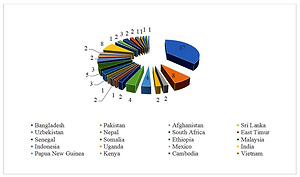Current issue
Archive
Manuscripts accepted
About the Journal
Editorial office
Editorial board
Section Editors
Abstracting and indexing
Subscription
Contact
Ethical standards and procedures
Most read articles
Instructions for authors
Article Processing Charge (APC)
Regulations of paying article processing charge (APC)
COVID-19/SARS-COV-2 / CLINICAL RESEARCH
COVID-19: access to information, health service, daily life facility and risk perception of foreigners during the coronavirus pandemic in South Korea
1
School of Social Sciences, Universiti Sains Malaysia, USM, Penang, Malaysia
2
Laboratory of Sustainable Rural Development, Graduate School of Global Environmental Studies, Kyoto University, Kyoto, Japan
3
Office of the President, West China Hospital, Sichuan University, Chengdu, China
4
Department of Computer and Information Science, Jouf University, Sakaka, Al-Jouf, KSA, Saudi Arabia
5
Department of Education Policy Studies, Pennsylvania State University, University Park, United States
6
Department of Sociology, Yeungnam University, Gyeongsan, South Korea
Submission date: 2021-02-03
Final revision date: 2021-07-27
Acceptance date: 2021-08-09
Online publication date: 2021-08-22
KEYWORDS
TOPICS
ABSTRACT
Introduction:
The coronavirus disease outbreak has become a top global challenge. Critical issues have emerged regarding access to information, health services, and daily necessities. Effective access to such components is expected to promote public safety and survival as well as to help combat social fear and risk perception. This study aims to fill this gap by exploring public perceptions of access, risk, and government response during the COVID-19 outbreak.
Material and methods:
A quantitative field survey using a structured mailed questionnaire was conducted to collect primary data from 100 foreigners living in various cities in South Korea. Access to information, health and daily necessities, and overall risk perception were examined based on individual reports regarding sources, availability, credibility, and overall satisfaction.
Results:
Our findings suggest that foreigners are receiving reliable information from public and private sources. Although access to health services, daily necessities, and protection measures were perceived as limited due to government protection measures, survey respondents tended to perceive an overall satisfactory government response in terms of providing resources and reducing risks related to COVID-19.
Conclusions:
Model analysis indicates that gender, home location, and duration of stay are significantly related to lower levels of risk perception. This study provides a new lens for policymakers, administrators, and academicians by which they can ensure smooth public access to information, health, and daily necessities regarding the protection and containment of coronavirus.
The coronavirus disease outbreak has become a top global challenge. Critical issues have emerged regarding access to information, health services, and daily necessities. Effective access to such components is expected to promote public safety and survival as well as to help combat social fear and risk perception. This study aims to fill this gap by exploring public perceptions of access, risk, and government response during the COVID-19 outbreak.
Material and methods:
A quantitative field survey using a structured mailed questionnaire was conducted to collect primary data from 100 foreigners living in various cities in South Korea. Access to information, health and daily necessities, and overall risk perception were examined based on individual reports regarding sources, availability, credibility, and overall satisfaction.
Results:
Our findings suggest that foreigners are receiving reliable information from public and private sources. Although access to health services, daily necessities, and protection measures were perceived as limited due to government protection measures, survey respondents tended to perceive an overall satisfactory government response in terms of providing resources and reducing risks related to COVID-19.
Conclusions:
Model analysis indicates that gender, home location, and duration of stay are significantly related to lower levels of risk perception. This study provides a new lens for policymakers, administrators, and academicians by which they can ensure smooth public access to information, health, and daily necessities regarding the protection and containment of coronavirus.
Share
RELATED ARTICLE
We process personal data collected when visiting the website. The function of obtaining information about users and their behavior is carried out by voluntarily entered information in forms and saving cookies in end devices. Data, including cookies, are used to provide services, improve the user experience and to analyze the traffic in accordance with the Privacy policy. Data are also collected and processed by Google Analytics tool (more).
You can change cookies settings in your browser. Restricted use of cookies in the browser configuration may affect some functionalities of the website.
You can change cookies settings in your browser. Restricted use of cookies in the browser configuration may affect some functionalities of the website.



